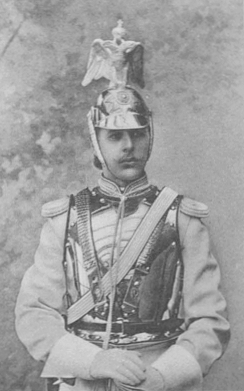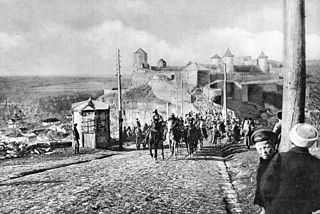
The Northwestern Army was a White Army that operated in the Pskov Governorate, Saint Petersburg Governorate, Estonia and Latvia during the Russian Civil War from 1919 to 1920. [1]

The Northwestern Army was a White Army that operated in the Pskov Governorate, Saint Petersburg Governorate, Estonia and Latvia during the Russian Civil War from 1919 to 1920. [1]

The origin of the Northwest Army was the plan to create an army by a group of reactionary Petrograd officers in the summer of 1918, in the territory controlled by Germany and with German support to confront the Bolsheviks. By October 10, 1918, a force of some 6,000 troops was created in the city of Pskov, which was called the Northern Corps. A quarter of them were officers of the former Tsarist army, and the rest was made up of local recruits, escaped Petrograd officers and prisoners of war released by the Germans.
The military supplies promised by the Germans didn't materialize and the Northern Corps had to retreat abruptly into Estonia at the end of November 1918. The Estonian Government, faced with a Bolshevik advance, accepted to take the White force into its territory and supply it, in exchange for passing under its control, and this despite the ideological difference between the independence fighters of Tallinn and the Russian White Movement. [2] Under pressure from the British gen. Gough who promised to arrange for Estonian and British military assistance in advance on Petrograd, Nikolai N. Yudenich formed a Government of Northwestern Region of Russia encompassing Petrograd, Novgorod and Pskov governorates that officially recognised Estonian independence. [3]
Together with the Finnish counterrevolutionary forces of Mannerheim, the Estonians and the Northern Corps were able to stop the advance of the Bolsheviks and to launch a counteroffensive in which they took Pskov and Yamburg in May 1919.
The White administration of the newly conquered territories was disastrous, as Rodzianko's subordinates unleashed a wave of terror against suspected Bolsheviks and against the Jewish population in general.
In June, the Northern Corps, now renamed the Northwestern Army, approached Luga, Ropcha and Gatchina, threatening Petrograd. But the Bolsheviks mobilized their reserves and aligned 40,000 men against the Northwestern Army supported by two Estonian divisions. On August 1, the Bolsheviks launched a counter-attack and drove back the Estonian troops, who were reluctant to fight outside their country. On August 5, Yamburg fell and Pskov was recaptured by the Reds on August 28.
On October 12, 1919, the Northwestern Army, some 18,500 men strong against 25,000 on the Red side, forced the frontline at Yamburg and seized on October 16 Luga and Gatchina. On October 20 Tsarskoye Selo fell into the hands of the White troops, who were now at the gates of Petrograd. They captured the Pulkovo Heights, the left flank of the Army entered Ligovo and advanced units engaged the enemy in skirmishes as far as the Ijorski factories. But the lack of forces and means, Estonia's lack of support, the disobedience of Pavel Bermondt-Avalov and his West Russian Volunteer Army, the passivity of the British fleet, and the Red numerical superiority made it impossible to take Petrograd. After ten days of fierce fighting with the Reds, whose numbers had risen to 60,000, the North-West Army was pushed back by the 7th and 15th Red Army from November 2, 1919 and retreated fighting into Estonia in the Narva region East of Narova river. The last and unsuccessful attempt of the Reds to capture Narva from the Whites was undertaken on 17 December 1919.
During April–December 1919 the Soviet Russian government and their Estonian counterpart were involved in the peace talks that ended with 1920 Tartu (Yuriev) Peace Treaty. Its Article 7 provisioned that the parties cease to support the forces hostile to each other, and undertake to disarm and neutralize these on their own territory.
Once the retreating North-Western Army, the Red prisoners of war and the refugees fleeing the Reds in total of about 40-50 thousand approached Narva, Estonians first refused to allow the train to pass through the bridge over Narova river motivating it with a fear of the typhoid epidemic that hit the army. Its personnel was ordered to stay in cold carriages in Ivangorod (then Eastern part of Narva) on a narrow landstrip between the river and the newly-agreed Russian-Estonian border. An eyewitness of these events, writer Alexandr Kuprin, reported of numerous deaths from the cold and starvation in one single night, mostly women and children. [4] Others recall hundreds dead bodies transported in the lorries and buried in the open graves in the suburbs of Narva. [5] Typhus death toll in Narva is estimated at 4000. Some time thereafter trains were allowed to pass to Estonia proper, where 15,000 soldiers and officers of the Northwestern Army were disarmed, and 5,000 of them were interned in camps, partly on the open air. [6] Around the same number of the former soldiers were under supervision employed in logging in the nearby forests, shale mines and in agricultural field works, as the government of Estonia claimed it could not feed such number of people for free. [7] [8] [9] Those who were caught more than 2 versts away from the designated working places were subject to deportation to Soviet Russia. The former anti-Bolshevik allies, demobilized Russian soldiers and officers, were deemed as a "20-thousands large gang" that somehow had to be disposed of. [1] For example, it was also suggested to divert the soldiers to the large Russian villages on the lake Peipus (Chudskoye) since "...should Typhus spread there, it will not be that painful to see the number of Russians there to diminish". [1] According to the accounts of an officer Kuzmin, his Talabsky regiment was disarmed and then pushed back into Narova river where it was shot by the Reds. General Yudenich accused of an attempt to escape with the Army's funds was arrested by men of Bułak-Bałachowicz with the tacit consent of the Estonian authorities, before being released after the intervention of the commander of the English squadron anchored at Tallinn. [10] This misconduct was addressed, yet to no avail, in a letter of protest from the former member of the Russian Provisional government, Guchkov, to Winston Churchill.
However, as the Estonian newspaper Sotsial-demokraat reported on 30 November 1919, the living conditions of about 4000 refugees then residing in Wesenberg county had been improved and the food was provided to them at the expense of American charity organizations. [11] For the needs of medical treatment eleven Russian hospitals all across Estonia were established by the Estonian Army using the facilities of the Northwestern Army, and six more by the Estonian and American Red Cross. [12] On January 22, 1920, by decree of Nikolai Yudenich, the Northwestern Army ceased to exist, [13] the Army's funds were distributed as the final salary and its remaining property was requisitioned [6] by the government. In total around 17 thousand died after internment, and survivors were mostly denied to permanently stay in Estonia and fled further to Central and Western Europe. Yudenich went into exile in France, where he died near Nice on October 5, 1933.
In 2016 in Estonia the newspaper "Prinevskiy Kray" of the Northwestern Army was digitized by the enthusiasts. [14]

The Estonian War of Independence, also known as the Estonian Liberation War, was a defensive campaign of the Estonian Army and its allies, most notably the United Kingdom, against the Soviet Russian westward offensive of 1918–1919 and the 1919 aggression of the pro–German Baltische Landeswehr. The campaign was the struggle of the newly established democratic nation of Estonia for independence in the aftermath of World War I. It resulted in a victory for Estonia and was concluded in the 1920 Treaty of Tartu.

Nikolai Nikolayevich Yudenich was a commander of the Russian Imperial Army during World War I. He was a leader of the anti-communist White movement in northwestern Russia during the Civil War.

Alexander Pavlovich Rodzyanko was an officer of the Imperial Russian Army during the World War I and lieutenant-general and a corps commander of the White Army during the Russian Civil War. He also competed at the 1912 Summer Olympics.

The Soviet westward offensive of 1918–1919 was part of the campaign by Soviet Russia into areas abandoned by the Ober Ost garrisons that were being withdrawn to Germany following that country's defeat in World War I. The initially successful offensive against the Republic of Estonia ignited the Estonian War of Independence which ended with the Soviet recognition of Estonia. Similarly, the campaigns against the Republic of Latvia and Republic of Lithuania ultimately failed, resulting in the Latvian–Soviet Peace Treaty and Soviet–Lithuanian Peace Treaty respectively. In Belarus, the Belarusian People's Republic was conquered and the Socialist Soviet Republic of Byelorussia proclaimed.

The Allied intervention in the Russian Civil War consisted of a series of multi-national military expeditions that began in 1918. The initial impetus behind the interventions was to secure munitions and supply depots from falling into the German Empire's hands, particularly after the Bolsheviks signed the Treaty of Brest-Litovsk, and to rescue the Allied forces that had become trapped within Russia after the 1917 October Revolution. After the Armistice of 11 November 1918, the Allied plan changed to helping the White forces in the Russian Civil War. After the Whites collapsed, the Allies withdrew their forces from Russia by 1925.
Stanisław Bułak-Bałachowicz was a Polish-Belarusian general and veteran of World War I, the Russian Civil War, Estonian War of Independence, Polish-Soviet War, and the Invasion of Poland at the start of World War II. He is remembered as a national hero of the Belarusian opposition and of the Belarusian minority in Poland.

Viktor Eduard Kingissepp was an Estonian communist politician, the leader of the Estonian Communist Party.

Kingisepp, formerly Yamburg (Я́мбург), Yam (Ям), and Yama, is a town and the administrative center of Kingiseppsky District of Leningrad Oblast, Russia, located along the Luga River 138 kilometers (86 mi) southwest of St. Petersburg, 20 kilometers (12 mi) east of Narva, and 40 kilometers (25 mi) south of the Gulf of Finland. Population: 48,488 (2010 Russian census); 50,295 (2002 Census); 49,954 (1989 Soviet census).

The Estonian Workers' Commune was a government claiming the Bolshevik-occupied parts of Republic of Estonia as its territories during the Estonian War of Independence and the Russian Civil War. It was recognised as an independent state only by Russian SFSR on December 7th, 1918.

The British campaign in the Baltic 1918–1919 was a part of the Allied intervention in the Russian Civil War. The codename of the Royal Navy campaign was Operation Red Trek. The intervention played a key role in enabling the establishment of the independent states of Estonia and Latvia. It failed to secure the control of Petrograd by White Russian forces, which was one of the main goals of the campaign.

Anatol Leonid Fürst von Lieven was a Russian military commander from the Baltic German princely house of Lieven. During the Russian Civil War he commanded a White force in Latvia known after him as the Liventsy.
Estonian Riflemen, Estonian Red Riflemen, Estonian Red Army, Estonian Red Guards were military formations assembled starting 1917 in the Soviet Russia.
The 11th Rifle Division was a military formation of the Soviet Union's Red Army. Its personnel were involved in the protection of the demarcation line in Pskov, defensive battles against the Army of the Southern Front in Krasnov Novohopersk - Borisoglebsk, against the army and the forces of Estonia, Bulak Balakhovich in Marienburg in defense of Petrograd and as the offensive against Yudenich's troops in Pskov the Luga-Gdov, Yamburg, Narva, Dvina-Rezhitsk directions, the Polish-Soviet war of 1920, in the suppression of the Kronstadt uprising participated in the Soviet-Finnish War and World War II.

The Operation Faustschlag, also known as the Eleven Days' War, was a Central Powers offensive in World War I. It was the last major offensive on the Eastern Front.

The Estonia–Russia border is the international border between the Republic of Estonia and the Russian Federation. The border is 294 kilometres (183 mi) long. It emerged during World War I, in 1918, as Estonia declared its independence from the then warring Russian and German Empires. The border goes mostly along the national, administrative and ethnic boundaries that have gradually formed since the 13th century. The exact location of the border was a subject of Estonian–Russian dispute that was resolved with the signing of the Border Agreement, but neither Russia nor Estonia have completed its ratification yet. It is an external border of the European Union.

The Regional Government of Northwest Russia was a short-lived White counter-revolutionary government formed on 10 November 1918, after the October Revolution.
The 15th Army was a field army of the Red Army during the Russian Civil War and Polish-Soviet War, which existed between 7 June 1919 and 26 December 1920.

The 7th Army was a field army of the Red Army during the Russian Civil War, which existed between November 1918 and February 1920.
This article covers the timeline of the Estonian War of Independence (1918−1920) and a few key events in the prelude and aftermath of the war.
The Battle of Petrograd was a campaign by the White movement to take the city of Petrograd. The city held significant value, notably as it was the same city that the October Revolution took place in. The battle was also at a critical point in the Civil War as the Whites has also been getting closer to Moscow and the Russian State was at its peak.
{{cite book}}: CS1 maint: location missing publisher (link)